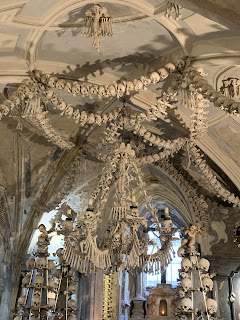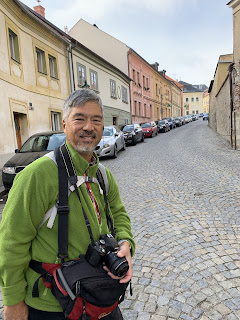Following breakfast in the Hilton’s excellent buffet, we boarded a Viking tour bus for an optional excursion to the city of Kutna Hora, which about a 90 minute drive outside Prague. There were 32 people signed up. The bus was a very comfortable Viking tour bus with 52 seats. So there were plenty of extra seats, allowing us to spread out a little.
While the bus had a bathroom on board, it was kept locked. Apparently in the Czech Republic, there is a law that says bus passengers can’t use the bathroom while the bus is underway, or so they told us, but we suspect it is more a matter of the bus driver not wanting to have to deal with cleaning the bathroom and dealing with the grey and black water dumping. We have been able to use the toilets on Viking buses in Hungary and Austria in the past, so this is probably a local issue. Fortunately, the drive out to Kutna Hora was not too long.
The majority of the passengers loaded up at the Hilton, but there were 6 passengers that had to be picked up at another hotel across town. As we headed to the Radisson, we received another daylight City tour with our guide Pavel providing commentary. All the guides we have had on this trip have been quite good. Many Czech’s learn English as a second language. Since WWII and Soviet occupation, German and Russian have been much less popular, despite the geographical proximity and common heritage under the Holy Roman Empire of the Germanic peoples.
Oddly enough, right after we picked up the passengers from the Radisson, the bus headed back to the Hilton, where it got onto an expressway ramp. Pavel explained that due to traffic, they were re-routed by Waze, Google Map data, and live reports from on the road from other Viking bus drivers.
The expressway is tolled electronically, and is very modern and well maintained. It was also quite clean, with a notable absence of litter along the expressway. There were quite a few large lorries (European term for Semi-Tractor-Trailer rigs and other large commercial vehicles with more than 4 wheels) using the expressway. There were quite a few communist era LEGO styled housing projects in the suburbs. Pavel explained how these are largely prefabricated concrete structures that are quite cheap and easy to put up.
Pavel explained that most people prefer the freedoms of democratic rule over Soviet occupation, which ended in 1989 with the Velvet Revolution and the collapse of the Soviet Union. The Czech Republic was apparently never actually a part of the USSR, remaining an independent country on paper, but in practice, it was ruled by a puppet regime acting on behalf of Moscow.
A significant minority long for the simplicity of life under Soviet occupation. If one didn’t have any ambitions, or strong opinions, it was easy to make do. There was no pressure to be productive. Work days were short, and there was little to do with your spare time anyways, so you spent a lot of time hanging out with your comrades drinking spirits distilled from plum juice or beer. There was no pressure to make money because there was nothing to buy, and everyone was equally poor, so there was no pressure to better oneself. Nowadays, if you don’t work, you can’t afford to live in a nicer apartment or drive a nicer model car. People like to have things, and like to do things that were never available during communist rule. They see how other people live, and desire improvements in their standards of living. I guess you can only be so miserable if everyone is equally miserable, but under democratic rule with open and free markets, you can be more miserable knowing everyone else is doing so much better.
As we drove through the suburbs, the forces of the market economy are evident everywhere in the form of shopping malls, big box stores, and car dealerships. We learned that the number one industry in the Czech Republic is automobile and mass transit production. The Czech Republic was the industrial hub of the Soviet Union, producing nearly all rail trams for subways and other light rail systems in the Soviet Block nations. They also produce Skoda cars, which is currently owned by Volkswagen. Pavel joked that before Volkswagen bought Skoda, the cars were not very reliable or well built. So the Germans taught the Czechs how to build high quality and reliable cars. In exchange, the Czechs taught Volkswagen how to cheat on their emissions tests.
When the Soviet Union collapsed, corruption and political abuses remained the norm. State owned industries ended up being swept up by a handful of oligarchs who used monopoly power to achieve incredible wealth. The current president of the Czech Republic apparently has made is wealth in canola oil production. As we drove out of the suburbs into the countryside, the country is covered with huge agricultural fields producing canola oil. Czech laws now require that canola oil be blended into all automobile and truck fuels, so that works out well for the President. That sounds suspiciously like what is going on with ethanol and corn in the USA.
We exited the expressway and descended into a valley where we could see several church spires rising above the surrounding city. Kutna Hora is a lot smaller than Prague, but in the 14th century, it vied with Prague for economic and political power. It was built on silver mines, which became the major source of wealth for Bohemian royals.
Our bus unloaded in front of a large cathedral called the Cathedral of Assumption of Our Lady and St John the Baptist. While this was a grand gothic structure, it was not our tour destination, which was tucked a couple of blocks into the adjacent neighborhood.
Our true destination was a much smaller Roman Catholic church surrounded by a cemetery called the Kostnice Sedlec. Within this little church’s basement are the bones of 40,000 to 70,000 human skeletons, artistically arranged in a macabre display.
Why? Well the story goes that in 1278, a monk was sent to the Holy Land by King Otakar II of Bohemia to bring back earth from Golgotha- the site of Jesus’ crucifixion. This was scattered over the abbey cemetery, making it a top destination for burial throughout Central Europe. The Black Death and the 30 years war resulted in massive overcrowding. Around 1400, a Gothic church was constructed in the center of the cemetery with a lower chapel to be used as an ossuary for the mass graves unearthed during construction. In 1870, a woodcarver employed by the Schwarzenberg family was hired to put the bone heaps into order. He created the macabre display, which includes the Schwarzenberg family crest made of human bones, and he even signed his work with human bones on the wall by the entrance.
The family crest includes a raven pecking the eyes out of a Turk’s decapitated head, and this scene is faithfully reproduced in bones as well. This has got to be a popular site to visit for Halloween!
From the Sedlec Ossuary, we walked to the magnificent Cathedral of St. Barbara, which is a UNESCO World Heritage Site. It features a combination of Gothic and Baroque design elements, and was completed in 1905. There is a spectacular gold orchestra of angels and cherubs in front of the massive organ pipes including a cherub behind what appears to be a drum set.
I didn’t spot the lead or bass guitarists, but there are woodwinds, brass and string players up there. The stained glass windows are also quite striking, but include some Art Nuevo stylings rather than true Gothic or Baroque scenes.
By the way, St. Barbara is the patron saint of miners. She was killed by her father when she refused to give up her Christian beliefs. In return for the favor, she had him smote with a lightning bolt from heaven which incinerated him instantly. Technically, that makes her patron saint of quick deaths, so it must have been preferable to be killed instantly in a mining accident, as opposed to being maimed for life.
We walked along Barborska street in front of the Czech Museum of Silver. There is a row of 13 baroque statues of saints on this pedestrian street reminiscent of the Charles Bridge. There was even another statue of St. Jan of Napomuk who was murdered by King Wenceslas IV for refusing to reveal his wife Queen Sofia’s confessional testimonies.
There is a silver mine associated with the Museum that you can tour, but our excursion didn’t include that. We did see a large group of Asian tourists clad in white overalls, hard hats and lamps headed up the hill towards the mine entrance.
We walked into the historical heart of Kutna Hora, which includes a Plague Column of the Virgin Mary Immaculate, erected in 1715 as a thanksgiving for the ending of the Plague.
We walked up the cobblestone streets past quaint shops selling silver, garnets and skeletal artworks to our lunch stop, the Dacicky Restaurant, which is elegantly decorated with a Medieval Theme dedicated to a local legend who lived in the 16th century. He was described as a renaissance rebel who founded a local brewery, and later gained renown as an author and poet.
It serves traditional Czech cuisine, which featured roast pork in a stewed plum sauce with mashed potatoes, served with its namesake beer, and followed with apple strudel and coffee.
We left the restaurant full and happy. Traffic back into Prague was terrible, necessitating an unscheduled bathroom stop at a truck stop, which was just like an American AM/PM minimart truck stop, including free bathroom facilities.
It took nearly 2 hours to get back to Prague through the traffic, which seemed every bit as bad as traffic in any American big city. Janet was still hoping to attend the evening’s folkloric dinner show excursion, but it was sold out, so we retired to our room relax and finish digesting our lunch.
At 8pm, we took inventory of our remaining stock of Czech Korunas and found we had just enough for some cheap Vietnamese food that we had seen on the day we arrived in Prague. The temperature has dropped substantially from our initial arrival when it was in the mid 60’s. Now it was down in the low 40’s, and expected to dip into the upper 30’s. We put on warmer clothes and got in an evening walk and got some Phad Thai noodles and a bowl of Pho. The food wasn’t all that great- no fresh bean sprouts or basil for the Pho, and the phad Thai was pretty bland, but improved with a squirt of Sriracha sauce. But the total was the equivalent of $12 US, and we got to unload most of our remaining Korunas. We kept a few 10 and 20 Koruna coins for potential toilet emergencies. We then walked along the trolley line, which was lined with shops and a couple of malls. There are plenty of young people walking about in the night. A theater show had just let out. There are a lot of smokers in Europe. We then turned around and retired to our hotel room.
We will need to repack our suitcases. It should be easy since we won’t have the weight constraints imposed by the airlines. Our bags need to go out at 10am tomorrow. We board buses for Passau to begin our Danube river cruise around Noon. So it looks like we get to sleep in.




























No comments:
Post a Comment
Note: Only a member of this blog may post a comment.